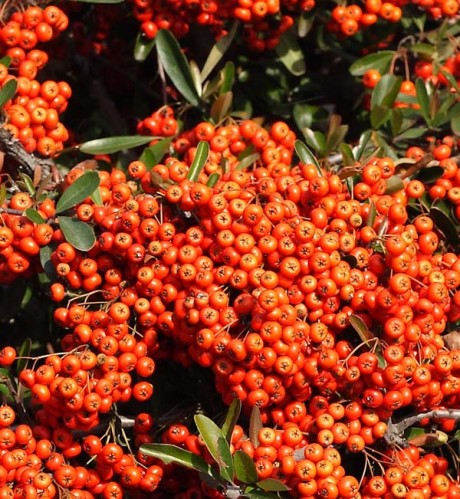Pyracantha: autumn fire
Plus garden to do's for October & November
By L.A. JacksonWhether showing off hot oranges or simmering reds, the mature berries of pyracantha are hard to miss in the fall. Its sharp barbs are also hard to miss, hence the alternate name “firethorn.”
Pyracantha is a well-suited shrub for Carolina Country conditions. Although it is best to plant this ornamental in well-drained soil, it will still do fine in heavy clay. After becoming established, it can also withstand hot, dry conditions. And for the best berry production, it demands full southern sun.
Some pyracanthas grow aggressively, reaching heights beyond 15 feet and spreads of 10 feet, but they can be tamed by regular prunings. To control their size, cut them back lightly in late fall — a chore that also provides fresh, colorful berry stems for indoor holiday arrangements. As an alternative, prune during the spring bloom to avoid cutting off all the flowering berries-to-be.
Don’t like to prune sticker bushes? Consider planting shorter, restrained varieties such as ‘Santa Cruz’, ‘Apache’ or ‘Red Elf’.
Lace bugs and spider mites can occasionally be a problem, but a few applications of insecticidal soap will keep these pests at bay.
Diseases might also sporadically crop up — two in particular are scab and fire blight. Scab can put a bad case of ugly on pyracantha. Infected bushes have off-green, sooty spots on the foliage, and the leaves eventually turn yellow and fall off, while the berries become covered with lesions and blacken.
With fire blight, new growth withers and turns black. If the disease advances far enough down the limbs, berries will also darken. One way to control this disease is to prune out the infected areas.
Prevention in the form of resistant cultivars is another way to keep these diseases away. Good choices include ‘Mohave’, ‘Rutgers’, ‘Shawnee’, ‘Red Elf’, ‘Apache’, ‘Teton’ and ‘Pueblo’.
Garden To Do’s
October
- Winter squash and pumpkins store better if they are harvested with a few inches of stem still attached.
- Raked leaves have to go somewhere, so why not dispose of them while preparing for next year’s garden? Both jobs can be done at the same time if you use “useless” leaves to start a compost pile.
- As perennials die back or are pruned down for the season, place markers beside them so they won’t be dug up during next spring’s planting frenzy.
- Add cheerful color to the fall and winter gardens by starting beds of pansies now.
- Remove gasoline from any motorized equipment that will be stored for the winter.
November
- Light frost on your Brussels sprouts, collards, kale or spinach? Good! A little icy covering improves their taste.
- Any hardy herbs such as chives, dill, fennel, tarragon or rosemary that are still in the garden can be used as flavorings for herb vinegars, which make great Christmas presents for gardening friends.
- Have a strange spring-flowering bulb but don’t know which end to plant up? Plant it sideways.
- Rake spent foliage, fallen blooms and summer mulch out of the rose bed, and replace with a fresh, 2- to 3-inch-thick winter mulch.
- Remember your feathered friends this winter by regularly cleaning and refilling the birdbath and feeder. Also, on extremely cold days, remove ice from the birdbath and replace it with fresh water.
-
Share this story:
{ampz:Custom share for module}

Comments (1)
What do you think?
Caroline Ryan |
July 10, 2020 |
reply